Der fliegende Holländer (The Flying Dutchman)
Richard Wagner (Music & Libretto)
West Bay Opera
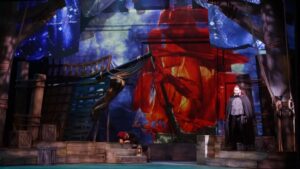
First a French horn and then a trumpet raise clarion calls demanding attention, soon to be followed by conversing, melodic strings and winds as projected clouds gather on the stage before us. As a storm’s fury increases, all sections of the orchestra respond, with the building waves of an angry ocean clearly perceived. The intensity is for the moment broken as a clarinet boldly announces what might be a calming, but a brass-fueled fury returns as wave after wave of the sea storm’s might washes over us and draws us almost to the edge of our seats in anticipation of doom. But suddenly clouds depart and the peaceful, calming notes of harp and flute signal a storm’s end.
With resounding beauty, the twenty-four-piece West Bay Opera Orchestra – under the leadership of the company’s Artistic Director, José Luis Moscovich – gifts its audience with an Overture that clearly is Wagnerian in its scope, might, and cinematic qualities and forcefully sets the scene for the master’s first, truly successful opera, Der fliegende Holländer (The Flying Dutchman), premiering in 1843. A myth arising from the 17th-century golden age of Dutch maritime supremacy serves as the basis of Richard Wagner’s libretto – a once-held belief that there existed a red-sailed, ghost ship doomed to sail the seas forever due to a deal made by its captain with Satan.
West Bay Opera, under the inspired stage direction of Ragnar Conde, presents a gripping and glorious retelling of this tale of one man’s seemingly impossible search for redemption and one woman’s unconditional love and willingness to be his long-sought angel. With a cast of incredibly charismatic principals whose voices would be the envy of any opera company, West Bay Opera ends its 67thseason with a not-to-be-missed, fully engrossing and big-sounding production.
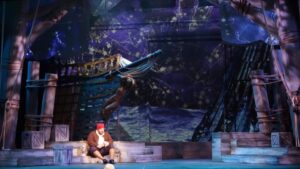
The Overture’s sea storm has delayed a Norwegian ship full of homesick sailors and their return to awaiting families, their home port only a short distance away from their current port of safety. The Captain has left his Steurmann (the helmsman) on the night watch, with Salvatore Atti immediately setting the bar high for the performers to follow as he gracefully sends his tenor notes to upper ranges, allowing them to linger just long enough to underscore the love he has for a girl onshore awaiting his arrival.
As an orchestra’s magnitude once again begins to mount, the watchman falls asleep just as the foreboding, blood-red sails of another ship approaches the overnight port. Onto the shore comes a Captain clad in black, and our subsequent introduction to the mythical Dutchman is nothing short of stunning.
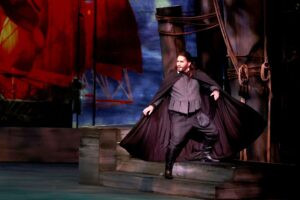
From his opening, deeply profound notes of baritone, Robert Balonek as the Dutchman commands the stage. As he mournfully sings of his eternal doom, his own frustration bellows forth that no matter how much he has tried – purposeful wrecks on rocky shores or intentional battles with pirates – “Death I found not.” Ghostly is his appearance with wide-opened eyes that stare vacantly off into some unseen horizon. As he continues to scorn his life of no death, his intoned notes shake from the depths of his tortured soul, leading to a pleading for God’s salvation in a voice so accordantly impressive, it is impossible not to think his prayer must be heard in the great above. With notes shuddering in their own dread and with a volume that near shakes the stage, he sings, “When all the dead rise, then I’ll fade into nothing … Eternal destruction, take me!”
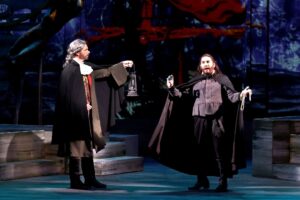
But with the entrance of the Norwegian ship’s Captain Daland, a new hope comes for the doomed Dutchman. This being the one day every seven years the Dutchman can come on shore to try and find salvation by securing the promise of forever love from a potential bride, he soon hears from the welcoming Daland that he has a daughter whose hand he will gladly give to the mysteriously appearing stranger, especially after Daland sees the wealth of pearls and precious jewels he might get in exchange. The duet of negotiation between the two is one in which Joshua Hughes’ Daland secures our admiration for his full-voiced, highly expressive, bass-baritone pipes. Two sonorous voices interact with notes now full of new hope – one for riches, one for freedom from endless misery – with their vibrantly sung optimism bolstered by a new, south wind and parting clouds as announced by a solid-sounding chorus of sailors and a triumphantly melodious orchestra.

Onshore we encounter a bevy of townswomen spinning and sewing, pleasantly tripping through lively notes as they await the return of their men. Sitting separate from the rest, a rather subdued Senta, daughter of Captain Daland, looks with pining glances at a dominant portrait on the nearby wall of a man she identifies as the fabled, ill-omened Dutchman. With a soprano voice magnificently clear and of definite drama, Meredith Bloomfield’s Senta recounts the myth of the Dutchman while also ardently pronouncing her desire to be the one that will be the path to his redemption. With a voice pleading in its soprano purity, she prays to the portrait, “May God’s angel show me to you.”

The listening womenfolk respond in the clicking, chirping sounds of gossip, their quite hilarious reaction intertwined with an equally frenzied reaction by the orchestra. They know that Senta is actually promised to Erik, who now enters the scene as John Kun Park introduces yet another principal’s electrifying, exciting voice.
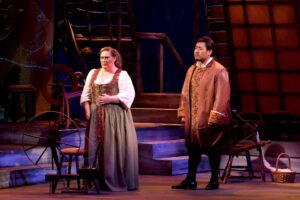
His tenor rings forth in rolling waves that noticeably shift in their character. After declaring passionately his love of Senta, his vocals sound doubt and worry as he observes her obsession with the Dutchman’s portrait, only to be followed by a trumpeting recounting of last night’s dream that portended of events in fact soon to occur – a dream where the Dutchman in the hung portrait will arrive to be lovingly welcomed by the woman who is Erik’s betrothed.
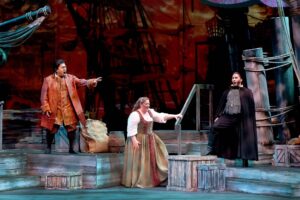
The stage is now set for the rest of the high-drama story to unfold, with each of these three principals – Dutchman, Senta, and Erik – primed to astound in ever-greater manner with voices that separately and together explode in power, precision, and passion. As is true in many Wagnerian operas, there are long segments when only a couple of people are on stage – sometimes a trait that can be a bit deadly as Wagner’s impressive music can be presented by some directors with principals mostly in stationary positions as if presenting a concert rather than a story. But under Ragnar Conde’s direction, there is conveyed a sense of tension, of anticipation, and of emotion that is commnicated by well-designed, well-timed movement around the stage of whoever is in the midst of a rather long sequence of song.
Principals have also been well-directed to be vividly expressive as actors as well as singers. There are numerous, brilliantly staged scenes such as Senta and Dutchman’s first meeting where their silent, longing stares directed at each other speak their own libretto and where each shows in their vivid, facial landscape alternating feelings of some fright and much hope of where this initial meeting might lead.
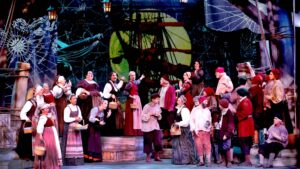
Peter Crompton’s combined physical and projection set designs strikingly establish a ship at sea with a crew struggling to harness wind-filled sails, a port with its protruding docked ship’s bow edging into a wooden port’s columns and steps, and a town’s lanterned community center full of whirling spins. Callie Floor completes the period’s and location’s feel through an array of sea-faring and portside costumes while Steve Mannshardt’s lighting mastery brings flashes of storms, shadows of night, and warmth of a sewing gathering all to bear. Bruce Olstad has well-prepared the stage-filling, richly harmonizing chorus of townswomen and sailors as well as an unseen chorus of ghostly sailors whose haunting harmonies sound as if they are flying somewhere in the air around us.
As is at this point surely obvious, I highly recommend heading to Lucie Stern Theatre in Palo Alto to enjoy an evening of high seas drama based on a tale full of myth and mystery enwrapped with the magnetic power of love sought at all costs. My only regret of the evening was that the thrilling conclusion of the legend is projected at the same time the outer curtain was closing, barely giving us as audience a second to ascertain whether this is an ending of ‘happily ever after’ or of a Shakespearean tragedy. Warning: Don’t blink at the end; and you’ll know exactly which it is.
Rating: 5 E
A Theatre Eddys Best Bet Production
Der fliegende Holländer (The Flying Dutchman) continues May 28, June 3, and June 4 in production by West Bay Opera at Lucie Stern Theatre, 1305 Middlefield Road, Palo Alto, CA. Tickets are available online at https://www.wbopera.org, by phone at 650-424-9999 or by email at boxoffice@wbopera.org.
Photo Credits: Otak Jump
